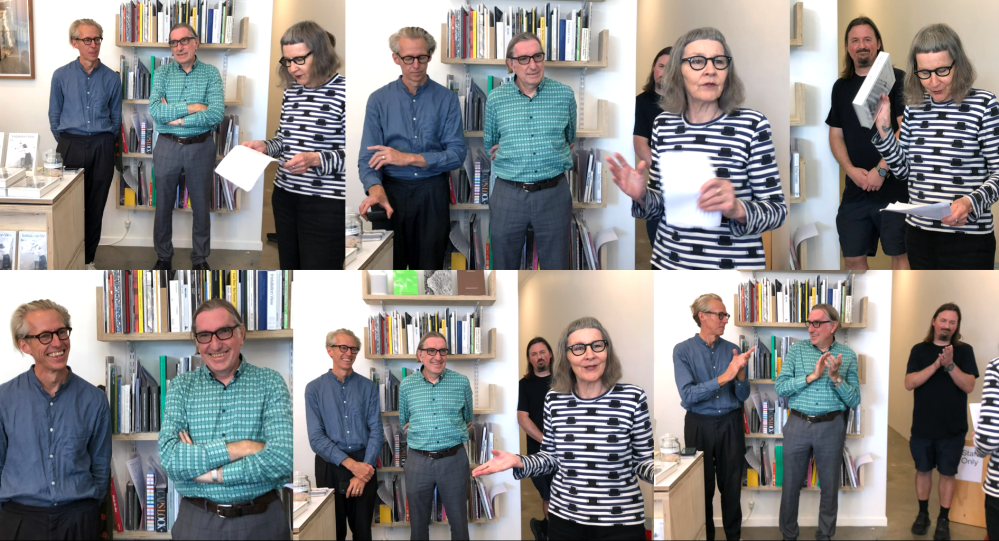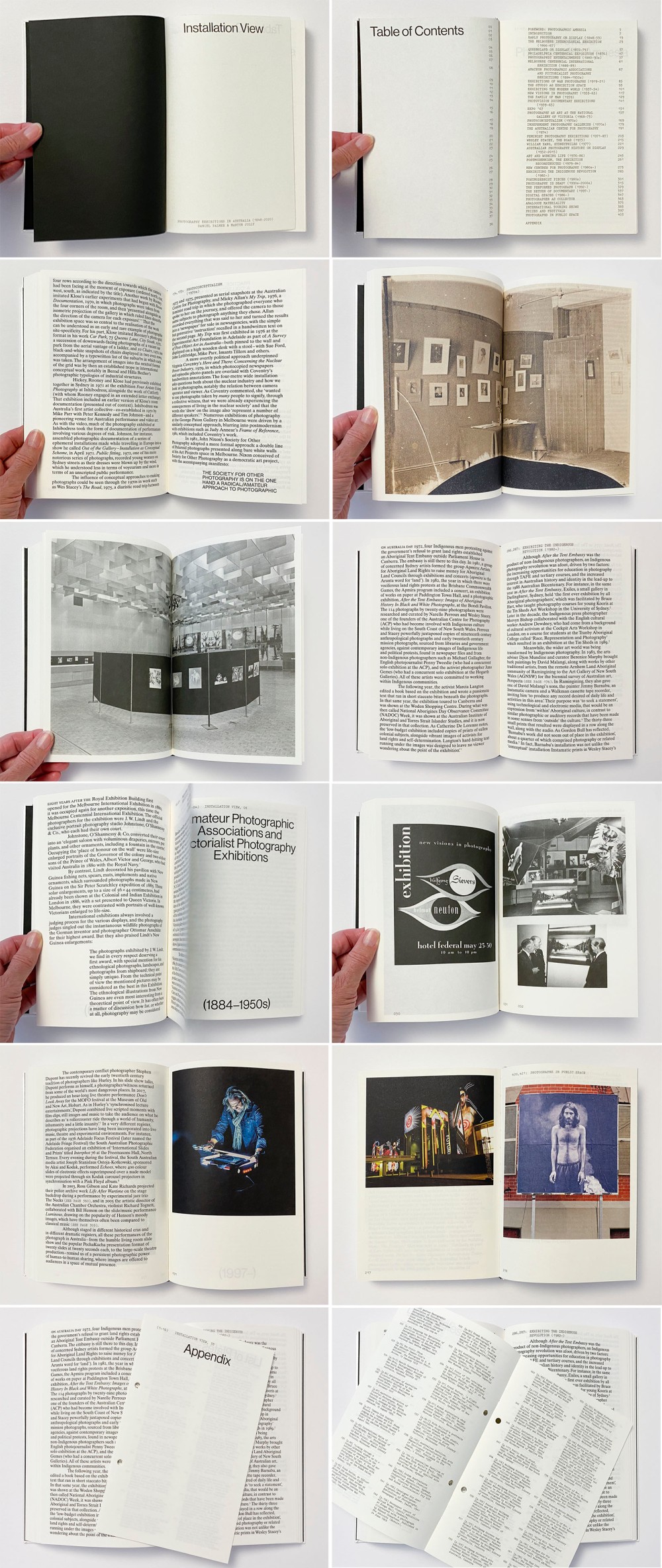On Sunday March 27, 2022 at the Perimeter HQ in Thornbury Melbourne, a group of photography enthusiasts met to witness the launch of an extensively researched publication by Daniel Palmer & Martyn Jolly entitled – Installation View: Photography Exhibitions in Australia (1848-2020).
The Launch was part of the Melbourne Art Book Fair programme.
Installation View offers a significant new account of photography in Australia, told through its most important exhibitions and modes of collection and display. From colonial records to contemporary art, the book presents a chronology of rarely seen installation views from both well-known and forgotten exhibitions, along with a series of essays that tell the story of the individuals and institutions that have proved intrinsic to the public circulation of photographs. At once specific and widely contextual in its scope, this longterm research project from two of Australia’s leading academics and educators in the field enriches our understanding of the diversity of Australian photography by looking at what lies beyond the frame. Installation View speaks not only to pictures, but to the people and the places that nurture them. (TEXT: From the Launch website)

Installation View was launched by Judy Annear who made the following comments in her speech:
Installation View is an important book by Daniel Palmer and Martyn Jolly published by Perimeter.
Firstly, I would like to pay my respects to the Wurundjeri People of the Kulin Nation as the Traditional Owners of the land on which we stand today and acknowledge that this land is unceded.
Installation View is a book which deals with photography exhibitions in Australia from 1848 to 2020. I found this book to be a page turner. Why? I do have a more than passing interest in the material – I saw most of the projects mentioned from the 1970s until 2020 and researched most of those earlier.
The writing and research in this book are solid and never dull, — even if the book doesn’t have an index! The illustrations are fascinating in their historical import, representation of artists’ intentions & audience view. The design supports both text and image.
The subject matter covers the more than 170 years that the photograph has existed in this country as an object intimately related to the evolution of display whether of its subjects, or of its self as both subject and object. This book traces the evolution of important aspects of modernity in Australia, an epoch we remain within. IT is important that we know and understand this epoch in all its nuances, most especially if we would like it to operate differently.
The photographic image is one of the strangest things we are ever likely to encounter yet it is the most ubiquitous of objects in modern life, and the thing we take the most for granted. The photograph is strange because it is an inanimate slice of the real – something uncanny. The popularity of the photograph, its various processes, the mechanical aspects of its origins, remain peculiarly mysterious to most of us. This is especially true in Australia where there is an institutional amnesia about the photograph’s importance whether as document or art object.
I followed the evolution of this book from its inception as an idea in Martyn and Daniel’s minds & observed as it became a kind of marathon. Part of that process was how to compress a rich and mostly unexplored history into a more than 400-page book?
I’m going to read a little of the foreword to give you some idea of the lucidity and care which has gone into the making of Installation view –
‘This book invites you to visit photography exhibitions of the past and actively imagine what it might have been like to be there….
The collection of …installation views… marks our contribution to a fight against the omissions of visual history. This is a book …. that seeks to preserve not only photographs, but also bring to light how they were first socialised within the life of Australia.
The complex dynamic between a scene of a photograph’s public reception, its documentation, and the individual photographs themselves, lies at the core of this book.’
Installation view invites the reader on a series of promenades through recent history, into spaces and places where artists, practitioners, curators, historians, have intervened to encourage an awareness of the treasure that is the photographic object and its embeddedness in our shared visual history.
As someone who has spent time trying to figure out how to present in new ways both the unknown & the very known to audiences so that they can find new readings and ways to think about visual culture and art objects, Installation view is not only a valuable record but a provocation. Artists have embraced each new technological innovation and repurposed these for their own ends. They have also revisited past methods, approaches, contexts, and reconsidered these. They often either pushed the envelope in new ways, or reinvigorated historical artefacts, or both. They are the makers, and this comes through clearly in this book.
Installations and views require space and relationships. We can’t ‘read’ an installation or a view without context. When I worked as a curator, a role I walked away from 6 years ago to focus on research and writing, I felt and still do that I had done all I could within the confines of major institutions. Photographic exhibitions, like any art exhibition, require relationships of trust. These relationships of trust have to be top down as well as bottom up, and spread toward and from audiences. This trust cannot coexist with being risk averse!
Some of the issues for photography have been its relatively small scale, serial nature, and close relationship to commercialisation and technologies.
The august institutions find it easier to focus on large scale single works that give more bang for the buck – they are easier to market, and to store, require only awe from an audience, and lots of bright light. Photographs are tricky objects, often needing more complex storage, low light, and they can’t hang on the walls indefinitely. They usually can’t be promoted as costing millions.
As Fran Leibowitz said about art auctions – why do people applaud the money and not the art?
Installation view is about much more than photography exhibitions in Australia – it is about the ground-breaking artists and photographers who should be celebrated for their approach whether in the making or presentation of their work, and whether in the 19th, 20th or 21st centuries. Installation view also celebrates the researchers who give back our photographic history to audiences and artists when institutions, regardless of their collections, are only erratically prepared to do this.
Buy and read this book – it is invaluable.
.
©Judy Annear 2022
Judy Annear is a writer who, from the late 70s until the 2010s, also worked with images, objects and their display. She is Honorary Fellow at the University of Melbourne School of Culture & Communication.
.
SOME IMAGES OF THE LAUNCH
Supplied courtesy of RUTH MADDISON

.
ABOUT THE BOOK:
The table of contents in the book lists 37 chapters and an Appendix, a separate booklet is #38.
A selection of topics include:
- Early photography of display (1848-59)
- Photographic entertainments (1880-90s)
- Amateur photographic associations and pictorialist photography exhibitions (1884-1950s)
- New visions in photography (1953-63)
- Photography as art at the National Gallery of Victoria (1968-73)
- The Australian Centre for Photography (1974)
- Feminist photography exhibitions (1971-87)
- Postmodernism, the exhibition reconstructed (1979-84)
- Photography I dead (1990s-2000s)
- International touring shows
- Photographs in public space
.
A LOOK INSIDE THE BOOK:

.
BIBLIOGRAPHIC INFORMATION
Daniel Palmer & Martyn Jolly – Installation View: Photography Exhibitions in Australia (1848-2020)
Published by: Perimeter Editions, Melbourne, 2021
Editors: Dan Rule, Justine Ellis
Design: Paul Mylecharane, Kim Mumm Hansen at Public Office
Copy editors: Nadiah Abdulrahim, Ash Holmes
Research Assistance: Elisa Desourcy, Shelley McSpedden, Kate Warren
Physical description: Codex, section sewn with cloth bound hard cover, 424 pages, 15.4 x 23cm.
Edition: 1,000
Printed by: Wilco Art Books, Netherlands
ISBN: 978-1-922545-00-8
This publication was supported by the Australian Research Council’s Discovery Projects Funding Scheme.
Installation View is Perimeter Editions #060
TO BUY THE BOOK:
Aust$ 59
Buy the book HERE
.
ABOUT THE AUTHORS
Daniel Palmer
Daniel Palmer is Professor and Associate Dean of Research and Innovation in the School of Art at RMIT University. His research and professional practice focuses on contemporary art and cultural theory, with a particular emphasis on photography and digital media. Prior to joining RMIT in 2018, Palmer was Associate Dean of Graduate Research and Associate Professor in the Art History & Theory Program at Monash Art, Design & Architecture. He also has a long association with the Centre for Contemporary Photography in Melbourne, first as a curator and later on the board of management. His book publications include Photography and Collaboration: From Conceptual Art to Crowdsourcing (Bloomsbury 2017); Digital Light (Open Humanities Press, 2015), edited with Sean Cubitt and Nathaniel Tkacz; The Culture of Photography in Public Space (Intellect 2015), edited with Anne Marsh and Melissa Miles; Twelve Australian Photo Artists (Piper Press, 2009), co-authored with Blair French; and Photogenic (Centre for Contemporary Photography, 2005). His scholarly writings, catalogue essays and reviews on photography and contemporary art have appeared in various journals, art magazines and publications internationally.
Martyn Jolly
Martyn Jolly is an Honorary Associate Professor at the Australian National University School of Art and Design. With a background in photographic practice, as well as photographic history and theory, he has developed theoretical and practice-led research into the implications of digital media and its historical antecedents for society; the impacts of digital media on photography curating; Australian photobooks; early Australian multimedia of the post war decades; magic lantern technology in Australia and the world; and contemporary reenactment strategies. His most significant publications are the books Faces of the Living Dead: The Belief in Spirit Photography, published internationally by the British Library, Melbourne University Press and Mark Batty in 2006, and Empire Early Photography and Spectacle: The Global Career of Showman Daguerreotypist J. W. Newland (Routledge 2020), co-authored with Elisa deCourcy.
.
.



Great book! Great writeup – bought one instantly!
Thanks for your good work Doug and Vicky
Al the best wishes Haru info@rimbooks.com http://www.rimbooks.com http://www.facebook.com/rimbooks/ +64 211705171
>
LikeLike
Thank you Bill – there’s quite a bit of reading ahead for you….
LikeLike
Thanks Haru — would be interesting to see a similar text on the NZ scene…. Cheers Doug+Vicky
LikeLike